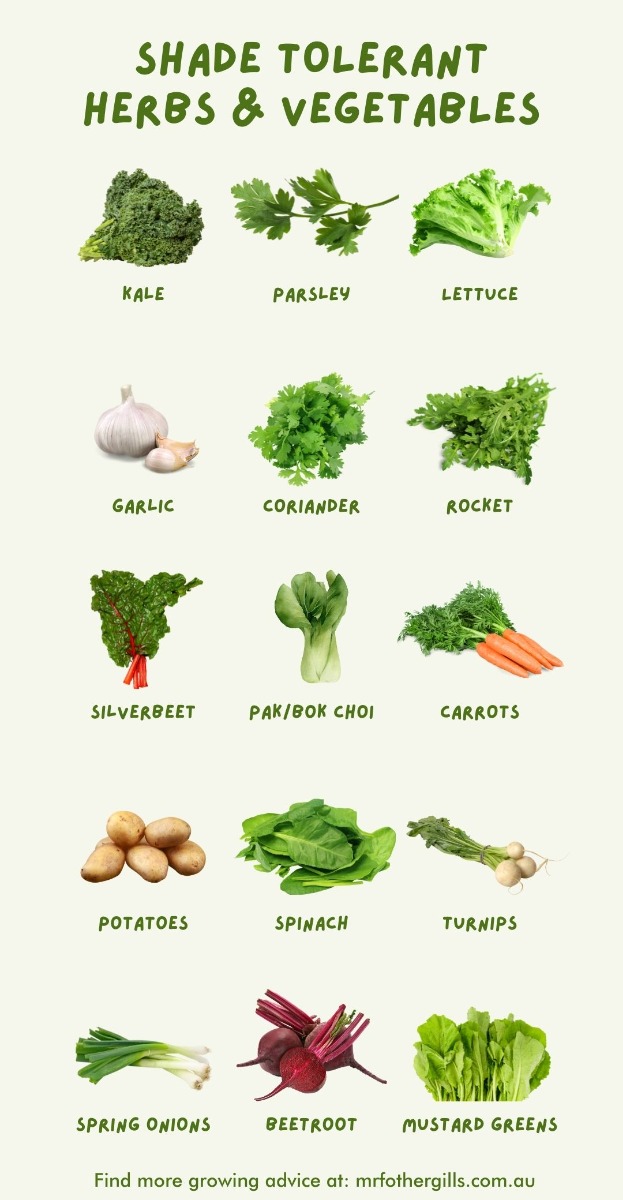Growing Vegetables In The Shade

You may hear in the gardening world that in order to have a successful vegetable garden you need to have a yard that receives full sun. Luckily this is not necessarily the case! There are many ways you can design your own space to produce food even if it isn't in full sun.
First, you need to look at the space you are working with. Take note of the areas in your yard at different times during the day and keep note of how each season affects the angle of the sun. You may notice one corner of the yard receives lots of morning sun however it is shaded for the rest of the day. It’s okay if you haven’t figured it all out as you can start off by growing vegetables in outdoor pots and move these around depending on the season and light conditions.
If you plan to plant trees in your backyard, consider some deciduous varieties that will offer more light during Autumn and Winter such as Japanese Maples or Liquidambar (they also can provide valuable material for making mulch for your garden). For your evergreen trees, try pruning off the lower bulkier branches to open up the space. When dealing with large trees such as Eucalyptus and Pines, it is always best to consult with a qualified arborist first.
Choosing the right vegetables
Variety is important when it comes to growing in the shade. Avoid growing crops that require a lot of heat and energy from the sun to ripen fruits such as large heirloom Tomatoes, Eggplants, Cucumber and Zucchini. These crops require long hours of daylight to establish and become fruitful during the season.
For gardens where the ground is shaded, choose climbing plants that can reach towards the sun. Climbing beans are great in Spring and Summer and Peas/Snowpeas are wonderful in the Autumn and Winter trained up a tall trellis or wall.
Luckily for us, many shade tolerant varieties can be harvested much sooner than long season crops. Focus on leafy green vegetables that have large leaves to soak up any available light. Lettuce, Spinach, Silverbeet and Kale are good crops to start with. Herbs are also a hardy option and can handle some low light conditions. Suitable herbs to try include Parsley, Chives, Mint and Coriander. By harvesting the outer large leaves on your salad greens and picking the tips of your herbs, the harvest can be staggered which means you get the most out of your crop!
Starting Seedlings
For good success, start your seedlings inside a mini greenhouse. Using a greenhouse will help your seeds germinate a lot faster as shady areas tend to be cooler than other parts of the yard. If you have the ability to put the greenhouse in an area that has sunlight until your seedlings are ready to transplant, it will help kick start their growth. Seedlings germinated without any light at all will quickly become very leggy and pale making them quite fragile. Once you have established some healthy seedlings, it is time to transplant them into their final growing spot.
It is important to be mindful of your watering schedule as dark areas can easily become too damp. This moist environment can lead to fungal and disease issues for your precious plants. Give your plants a little extra room to increase airflow and try watering the soil only and not the leaves.
Keep in mind that your plants will grow slower than those in full sun so be patient and enjoy the process. If you are still struggling to create the garden of your dreams, a Mr Fothergill's hydroponic indoor smart garden may be for you.



